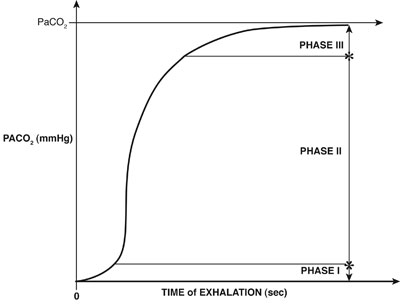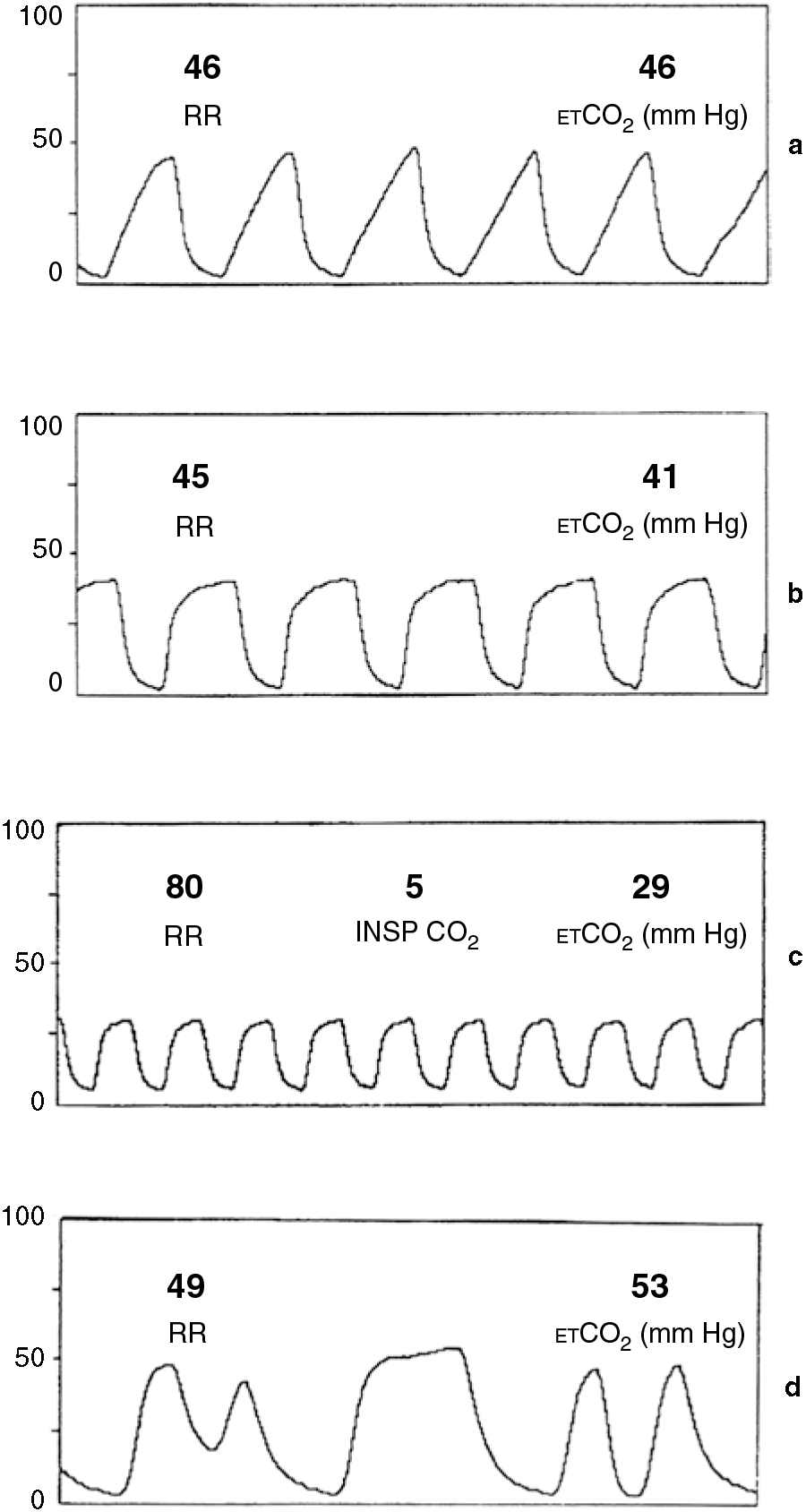end tidal co2 range pediatrics
So the short answer is you are right about the ranges 35-45 but that is for actual PaCo2 drawn from an ABG. End-tidal CO 2 et CO 2 monitoring is not a new modality in the pediatric emergency department PED and emergency department.

Pdf Capnography In Pediatric Critical Care Unit And Correlation Of End Tidal And Arterial Carbon Dioxide In Ventilated Children
Pediatrics 1995 95 3.
. End-tidal CO2 monitoring is an exciting non-invasive technology that is more commonly used in the emergency department intensive care unit and in the prehospital setting. End-tidal carbon dioxide CO 2 monitoring is useful in the prehospital setting emergency department intensive care unit and operating roomCapnography provides valuable timely information about the function of both the cardiovascular and respiratory systems. Capnography measures the amount of CO2 present at the end of exhalation end-tidal CO2 or ETCO2 displays a waveform that represents air movement through the respiratory cycle and continuously.
End-tidal CO 2 monitoring is the single most useful method in confirming endotracheal tube position. Once that has been done you can use an end tidal Co2 monitor as opposed to drawing multiple ABGs. As stated before end tidal is slightly different.
PEFR measures were completed on 43 patients and PASS recorded on 100 patients. End-tidal CO 2 Et CO2 is the standard in operative care along with pulse oximetry for ventilation assessmentIt is known to be less accurate in the infant population than in adults. End-tidal carbon dioxide CO2 monitoring is useful in the prehospital setting emergency department intensive care unit and operating room.
End-tidal carbon dioxide levels and serum bicarbonate. Detector During Pediatric Cardiopulmonary Resuscitation. Both hypercarbia 1730 and hypocarbia 284 are observed commonly among NICU patients 60 61.
The mean initial EtCO 2 value was 35 mm Hg 95 confidence interval 343 to 361 mm Hg. It is the standard of care during certain procedures such as intubations and sedations and can be used in variety of clinical situations. 2 See Figure.
The normal end-tidal capnography wave form is basically a rounded rectangle. We would like to thank to Drs. End-tidal carbon dioxide monitoring is not as reliable as arterial blood gas analysis for monitoring PaCO 2 however it may have a role in.
Cerebral blood flow increases with hypercarbia and decreases with hypocarbia 57 59. Woodham and Railton for their comments on our work dealing with negative PaCO 2 ETCO 2 differences as reported with sidestream carbon dioxide monitoring during paediatric general anaesthesia 1We separately analysed the influence of age on the extent and incidence of negative PaCO 2 ETCO 2 differences. Many neonatal intensive care units NICU have converted to utilizing transcutaneous CO 2 tcP CO2 monitoringThis study aimed to compare perioperative Et CO2 to tcP CO2 in the.
One hundred thirty of 146 subjects who were approached were included in the final analysis. An important use of continuous ETCO 2. End-tidal carbon dioxide monitoring in neonatesInfant 2008.
Utility of end-tidal carbon dioxide detector during stabilization and transport of critically ill children. Application in neonates. Children 37 weeks gestation in Collaborative Pediatric Critical Care.
The mean TST with EtCO 2 50 mmHg was modestly correlated with apnea-hypopnea index AHI r 033. ETCO 2 can be used to detect trends in PaCO 2 and ETCO 2 alarm limits can be usefully used to maintain PaCO 2 within an acceptable range. Under normal conditions the end tidal CO2 is usually slightly less than the PaCO2 with a normal difference of 25 mmHg.
According to the book by Hockenberry and Wilson 2015 p 1140 normal values of ETCO2 are 30-43 mmHg which is slightly lower than arterial PaCO2 35-45mmHg. Its main use has been in verifying endotracheal tube position during mechanical ventilation and cardiopulmonary resuscitation but it is being studied and used for other purposes as well. During sedation capnography is often used to assess the breath-to-breath analysis of carbon dioxide concentration.
19 Toubas PL Duke JC Sekar KC McCaffree MA. End-tidal carbon dioxide monitoring in pediatric emergencies Pediatr Emerg. Evaluation of An End-Tidal CO 2 Detector During Pediatric Cardiopulmonary Resuscitation.
20 Bhende MS Thompson AE Orr RA. Also called capnometry or capnography this noninvasive technique provides a breath-by-breath analysis and a continuous recording of ventilatory status. Non-invasive end-tidal carbon dioxide monitoring by capnography.
Capnography provides valuable timely information about the function of both the cardiovascular and respiratory systems. To determine the utility of a disposable colorimetric end. Achieve end-tidal carbon dioxide ETCO220mmHg.
Quality EtCO 2 waveforms were present for 75 of total sleep time TST in 876 of 960 913 screening polysomnograms. We prospectively evaluated whether ETCO2 20mmHg during CPR was associated with survival to hospital discharge. End-tidal carbon dioxide ETco 2 monitoring provides valuable information about CO 2 production and clearance ventilation.
The mean disposition EtCO 2 value was 333 mm Hg 95 confidence interval 326 to 344 mm Hg. The median PCO 2 values in both cohorts were still maintained within the recommended range for preterm. Prior to the reading the monitor was left in place for approximately 5 minutes at which time an arterial blood gas value was obtained.
In fact its commonly called the ventilation vital sign. Non-invasive carbon dioxide monitoring Key points Harigopal S Satish HP. For those for whom laboratory studies were performed the mean serum bicarbonate concentration was 173 43 mmolL and the mean end-tidal carbon dioxide level was 342 52 mm Hg.
Note that this gradient may be considerably higher in situations where there is an increase in dead space. The PaCO 2 value varied from 19 to 86 mmHg. One hundred children were enrolled.
Microphonic versus end-tidal carbon dioxide nasal airflow detection in neonates with apnoea. End tidal CO 2 ETCO 2 is a type of non-invasive monitoring of carbon dioxide levels in ventilated neonates 1It provides a constant surveillance of expired CO 2 in ventilated infants. An end-tidal capnography waveform is a simple graphic measurement of how much CO 2 a person is exhaling.
P 00001 and with oxygen. It is best to get an ABG along side the end tidal to calculate the patients shunt. In normal healthy newborns the PaCO 2 is within the range of 3545 mm Hg.
Among the 322 children who were randomized 55 17 met pediatric criteria for hypoventilation. The mean difference between the transcutaneous and arterial CO 2 value was 194 mmHg with a 95 confidence interval of 012 to 407 mmHg. However et CO 2 may be underused in the PED setting.

Continuous Capnography In Pediatric Intensive Care Semantic Scholar

Continuous Capnography In Pediatric Intensive Care Semantic Scholar

Pdf The Correlation And Level Of Agreement Between End Tidal And Blood Gas Pco2 In Children With Respiratory Distress A Retrospective Analysis Semantic Scholar

Pdf Capnography In The Pediatric Emergency Department Clinical Applications Semantic Scholar

Respiratory Monitoring Department Of Pediatrics Uw Madison

Pdf Capnography In Pediatric Critical Care Unit And Correlation Of End Tidal And Arterial Carbon Dioxide In Ventilated Children

Covidien Adult And Pediatric Colorimetric Co Detectors Pedicap6 Pedicap Easycapii6 Easycap Ii From 4md Medical

Pdf Correlation Of End Tidal And Arterial Carbon Dioxide Levels In Critically Ill Neonates And Children
Emdocs Net Emergency Medicine Educationcapnography In The Ed Emdocs Net Emergency Medicine Education

Exhaled End Tidal Carbon Dioxide As A Predictor Of Lactate And Pediatric Sepsis The American Journal Of Emergency Medicine

Association Between Etco2 And Paco2 In Infants And Children Download Scientific Diagram

Neonatal Monitoring Chapter 10 Capnography

Continuous Capnography In Pediatric Intensive Care Semantic Scholar

Pdf Capnography For Monitoring End Tidal Co2 In Hospital And Pre Hospital Settings A Health Technology Assessment Semantic Scholar

Arterial And End Tidal Carbon Dioxide Difference In Pediatric Intensive Care Topic Of Research Paper In Medical Engineering Download Scholarly Article Pdf And Read For Free On Cyberleninka Open Science Hub

Capnography In The Pediatric Emergency Department Clinical Applications

End Tidal Capnography Can Be Useful For Detecting Diabetic Ketoacidosis Monitoring Copd Page 2 Of 4 Acep Now Page 2

Carbon Dioxide Monitoring In Children A Narrative Review Of Physiology Value And Pitfalls In Clinical Practice Humphreys 2021 Pediatric Anesthesia Wiley Online Library

Noninvasive Assessment Of Arterial Co2 From End Tidal Co2 In Pediatric Intensive Care Unit Of Al Zahraa Hospital Semantic Scholar